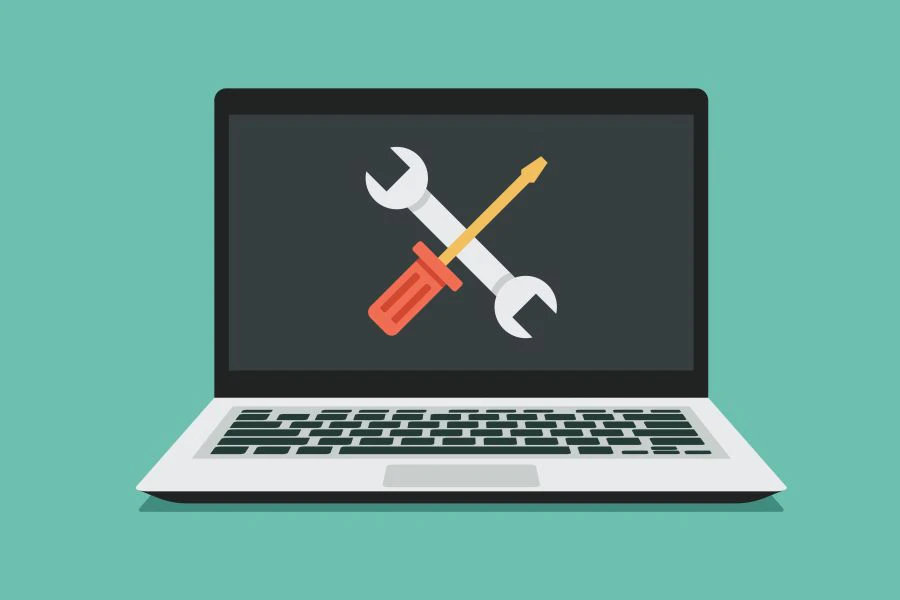
Computer/Laptop
Give a second life to your faithful companion
As a computer screen is getting older, it may no longer display certain pixels correctly. This results in a black dot, white dot, or a dot that is always on and stuck on one color. The origin of the failure can be attributed to the wear of the screen, but can also be due to poor contact caused by humidity, poor welding or having appeared following a shock. This defect only concerns the display and in no way threatens the general integrity of the laptop, but it can be visually very annoying, especially if the pixels in question are located right in the middle of the screen.
Before considering changing computers, a few manipulations can be tried to give a second life to your faithful companion.

A stuck pixel is not dead
The usual expression "dead pixel" is misleading, because in reality, two types of breakdowns can occur. If, regardless of the color of the adjacent pixels, a pixel is off, that pixel is effectively dead. Same if the pixel is white (in this case we speak of a hot pixel). In both cases, there is nothing to do, this pixel is dead!
On the other hand, if the pixel displays a different color than it should, all hope remains. This pixel is not dead, but simply blocked and there is still a small chance to fix it.
Of course, if your device is still under warranty, do not try to repair it yourself by following the methods proposed here, you can return it to the after-sales service or obtain an exchange.
Determine the type of failure
If it is easy to spot the bright white of a hot pixel, or a pixel stuck on a color that has nothing to do with the rest of the image, such as a red pixel against a blue sky, identify a pixel which is simply off is not obvious. Nothing looks more like an effectively black, dead pixel than a pixel displaying a dark tint. When in doubt, you are never safe from a good surprise, it is better to assume that that pixel is repairable.
Repair pixel(s)
To unblock a recalcitrant pixel, several methods are possible and none is more effective than another nor is there any 100% guarantee. If one method does not work, who knows, maybe the next method will. Here, listed in order of difficulty, or at least, of complication, methods that have proven themselves to be efficient.


#1 Let stand
A pixel can sometimes become momentarily defective when a display has been used too much or its components have become too hot. If a pixel crash has just happened, it costs nothing (just a little patience) to turn off your device and wait. This device should not be used for at least one hour and should be unplugged.
#2 Put some pressure on
Use a slightly sharp object, for example a used pencil, or the rounded wooden end of a small paintbrush. In any case, this object must not risk scratching the screen or be made of metal. Cover the end of this object with a small piece of fabric, or of tissue paper. You can hold this piece of fabric or tissue paper with a rubber band.
On the lit screen, press very gently on the recalcitrant pixel and only there. A small luminous halo appears around the pixel. Gently hold the pressure for a few seconds, wait a few seconds and start again. It will not work the first time, therefore you may have to try several times.
If it does not work after a few minutes, go to method #3. If the pixel is unblocked, it is imperative to turn off your device and let it rest for at least an hour, as in method #1, otherwise, the pixel may crash again.
#3 Use specialized software
There are many free or paid software utilities that can sometimes unlock a pixel. Paid or free software are equal. Among the best known, we can mention without particular preference: JscreenFix, PixelHealer, InjuredPixels, UndeadPixel, Pixel Réa.
These software utilities sometimes offer a test that highlights the defective pixels, because we do not necessarily see them all.
To unlock the pixels, the software displays, at screen refresh rate, a random sequence of red, blue and green colors. With a bit of luck, when the hue identical to a blocked pixel is displayed, it will be unblocked.
Without result, it is sometimes necessary to insist a little and start again the software several times in a row and do not hesitate to make another try the next day.
Due to the fast refresh rate display of the screen, people who have seizure medical disorders or are photosensitive should not use this method.


 Canada (English)
Canada (English)  México (Español)
México (Español)  USA (English)
USA (English)  América Central y el Caribe (Español)
América Central y el Caribe (Español)  Argentina (español)
Argentina (español)  Bolivia (español)
Bolivia (español)  Chile (español)
Chile (español)  Colombia (español)
Colombia (español)  Equador (español)
Equador (español)  Deutschland (Deutsch)
Deutschland (Deutsch)  France (Français)
France (Français)  Nederland (Nederlands)
Nederland (Nederlands)  United Kingdom (English)
United Kingdom (English)